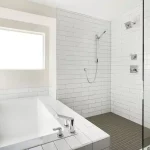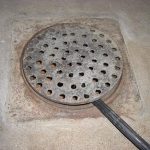If you have a washing machine in your basement, it is important to ensure proper drainage to prevent any water damage or dampness. This is where basement washing machine drain plumbing comes into play. By connecting your washing machine to the main drain pipe in the basement using a washing machine hose, you can easily drain the water and keep your basement clean and dry.
In this article, we will explore the best ways to connect your laundry with the basement drain plumbing using a hose. We will provide you with the necessary information to ensure that your washing machine is properly connected to the drain pipe, so you can avoid any potential issues with water damage or dampness in your basement.
Basement Washing Machine Drain Plumbing Considerations:
Consider the basement drain system
When installing a washing machine in the basement, you need to consider the type of drain system you have. There are three types of basement drain systems: floor drain, interior French drain, and exterior drain tile
A floor drain is the most common type of drainage system in the basement. It comes with most new constructions of homes these days. If you have a floor drain, you can easily connect the washing machine hose and allow the laundry to drain directly into the floor drain.
An interior French drain has a perforated pipe that collects and carries water into a pit. The water is then drained into the surface using a pump. The pipe is covered with crushed stone or gravel for protection and is installed right under the basement floor.
An exterior drain tile is usually located at the exterior perimeter of the basement. It collects waste water from the basement and ground and directly drains it into the municipal sewer line. Most homes have an exterior drain tile due to municipal building codes.
How far you have to lift the water?
When installing the washing machine in the basement, the pump needs to lift the used water to reach the surface level of your home. The pump will require lifting the water around 6 to 8 feet, so you must consider its pumping capacity when installing the pump. Don’t buy a big pump since you don’t need to pump out too much water from the washing machine. You should never install the drain line of the washing machine with the sump pump since it can contaminate the groundwater and cause health hazards.
Washing machine size and capacity
The size of the washing machine determines how much water it will use. So, with bigger washing machines, you need to drain more water. A standard washing machine at home has a 7KG (15.5lbs) capacity. If you have bigger washing machines such as 12KG or even more, you will need to drain more water.
Distance between the washing machine and drainage location
Since you will use a washing machine hose to drain the device, you must measure its distance from the basement drainage. The distance shouldn’t be too long so that the hose needs extra pressure to reach the draining spot. Most washing machines come with a 5ft to 10ft long hose. If the drainage location is too far away, you will need a hose extension.
How to Plumb a Washing Machine Drain in the Basement?
When installing a washing machine in your basement, you will need to consider the drainage system. There are three ways to plumb a washing machine drain in the basement: connecting the machine with the ceiling standpipe, raising your washing machine, or installing a washing machine tray and pump.
Connecting the Machine with the Ceiling Standpipe:
If you don’t have a floor drain in your basement, you may connect the washing machine drain hose with the standpipe on the ceiling. However, this method only works if the washer has enough pressure to raise the drain water against gravity. You must also consider how much the washer needs to lift the water.
To connect the machine with the ceiling standpipe, you will need to cut out the standpipe in the ceiling and install a Y-fitting in the cutout of the pipe. Finally, secure it with sturdy couplings. This is the most convenient and cheapest drainage system for washers in the basement, provided the washer has enough pressure to pump the water up to the ceiling.
Raise Your Washing Machine:
If your basement ceiling is 10 to 12 feet away from the floor, the washing machine might not have enough strength to pump out the water at that height against gravity. In that case, you will need to raise the washing machine.
You can raise the washing machine by mounting it over a sturdy, rugged platform. A wooden platform is easy and cheap to get or DIY at home. Alternatively, you may purchase a washing machine pedestal and put the device on it to lift it from the ground. This is a convenient option and costs only a few dollars.
Install a Washing Machine Tray and Pump:
When installing the washer in the basement, collecting its water in the tray and then pumping it out on the surface is a convenient and widely used technique.
First, install the laundry sink or tray and mount the pump underneath it. Then, connect the standpipe of the basement with the pump using a PCV pipe. Also, ensure that the washer drain hose reaches the sink or tray.
It is recommended to place them nearby. Otherwise, you will need a washing machine hose extension.
Problems Of Drainage And Installing A Washer in Basement
When you decide to install a washing machine in your basement, there are a few things you need to consider. One of the main issues is the potential for increased dampness in the basement due to the presence of the washing machine.
Another problem you may encounter is with the drainage system. Since most basements are situated below the municipal sewer line, it can be challenging to connect the washing machine to the drainpipe using a hose. This is because the hose needs to reach a higher position, which can be problematic.
To prevent condensation, you can also install a laundry sink in the basement. This will provide a convenient place to drain the washing machine and prevent any excess moisture from accumulating in the area.
Final Words
Installing a washing machine in the basement can be a simple task if you follow the right steps. As recommended by experienced plumbers, it’s best to follow basement washing machine drain plumbing suggestions to ensure a smooth installation process. With the right tools and guidance, you can save both time and money on the draining system installation. Remember to prioritize safety during the installation process, and seek professional help if necessary. With these tips in mind, you can confidently install a washing machine in your basement without any hassle.




